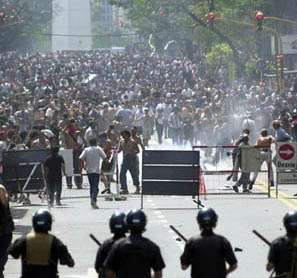 We've arrived on a Friday. Every Friday night since mid-December last year, there has been a massive cacerolazo in Buenos Aires, when the people converge in the political center of the city, the Plaza de Mayo, and create an enormous racket by banging on cacerolas, or saucepans. These huge cacerolazos developed spontaneously on the 19th of December 2001, the day when the uprising exploded, after smoldering in the provinces for several years, and now involving just about every sector of Argentinean society.
We've arrived on a Friday. Every Friday night since mid-December last year, there has been a massive cacerolazo in Buenos Aires, when the people converge in the political center of the city, the Plaza de Mayo, and create an enormous racket by banging on cacerolas, or saucepans. These huge cacerolazos developed spontaneously on the 19th of December 2001, the day when the uprising exploded, after smoldering in the provinces for several years, and now involving just about every sector of Argentinean society.
Argentina suffered two and a half decades of International Monetary Fund-(IMF) backed "free-market reforms," which meant privatizing everything: water, telephone systems, postal services, railways, electricity - you name it - even the zoo was privatized. When the Asian and Russian markets crashed in 1998, foreign investment dried up in the so-called "emerging markets." Argentina was hit badly, a major recession struck, and foreign lenders asked for their money back, on time.
According to the IMF, the only way the Argentinean government could repay the $132 billion debt, some of which dated from the military dictatorship, was by making more cuts in social spending, especially as many people, sick of political corruption, had stopped paying their taxes. Pensions, unemployment benefits, health care, and education all were cut drastically, and all state employees had their salaries slashed by 13%. It was the same old story repeated across the world - as countries are forced into deeper and deeper debt, the IMF strip mines their economies for the benefit of foreign banks and bond traders.
In fact, it was the bond markets, unsatisfied with the pace of the austerity plans, who proved to be even harsher task masters than the IMF. Unlike the IMF, they never bothered to send delegations to negotiate, they simply jacked up interest rates on debt issuances, in some instances from 9% to 14% in a fortnight.
Now, after four years of recession, one out of every five Argentineans is unemployed, and some economists say this could soon double. 40% of the population is now living below the poverty line, and another 2000 people fall below it every day. Hospitals are running out of basic supplies like bandages and syringes, schools are shutting down because teachers aren't being paid, child mortality and hunger is on the rise, and this is all occurring in what once was one of the wealthiest countries in the world, for decades considered the great success story of neoliberal development in the "developing" world, the star pupil of the "Washington Consensus," and the main advocate for free trade in the region.
As the recession worsened, Argentinean stock plummeted, and the unpopular austerity measures became increasingly vicious. Protests spread further across the country. Things climaxed in December 2001 when, grasping for straws, the government decided to try a complicated re negotiation of its debt repayments. Fearful that the entire economic house of cards was going to come tumbling down and that the currency would be devalued, thus wiping out their life savings, the middle classes panicked and withdrew about $135 billion from their bank accounts.
Fearing that a run on the banks would sink the economy, the detested finance minister, Domingo Cavallo, announced sweeping restrictions limiting the amount of money Argentineans could withdraw from their accounts. Known as the corralito, these measures included a monthly limit of $1000 on cash withdrawals in addition to caps on off-shore transfers. With all the facets of the crisis interlocking, the economy was effectively paralyzed.
The IMF freaked out, due to the banking restrictions and the debt repayment plan, which would severely impact foreign banks, as they own 40% of Argentina's debt. They refused to lend any more money, and within weeks Argentina defaulted on its loans, the first time a country had done so in years. From this moment the economy was in free fall. On the 13th of December, a general strike called by major unions brought the country to a grinding halt for 24 hours. Six days later the popular rebellion exploded into the streets, where it remains today.